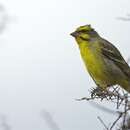en
names in breadcrumbs


The yellow-fronted canary (Crithagra mozambica) is a small passerine bird in the finch family. It is sometimes known in aviculture as the green singing finch.
The yellow-fronted canary was formerly placed in the genus Serinus, but phylogenetic analysis using mitochondrial and nuclear DNA sequences found that genus to be polyphyletic.[2] The genus was therefore split and a number of species including the yellow-fronted canary were moved to the resurrected genus Crithagra Swainson 1827.[3][4]
This bird is a resident breeder in Africa south of the Sahara Desert. Its habitat is open woodland and cultivation. It nests in trees, laying three or four eggs in a compact cup nest. It has been introduced to the Hawaiian Islands, where it is found on western Hawaii, southeastern Oahu and Molokai.[5]
The yellow-fronted canary is a common, gregarious seedeater. It is 11–13 cm in length. The adult male has a green back and brown wings and tail. The underparts and rump are yellow, and the head is yellow with a grey crown and nape and a black malar stripe. The female is similar, but with a weaker head pattern and duller underparts. Juveniles are greyer than the female, especially on the head.
Its song is a warbled zee-zeree-chereeo.
The yellow-fronted canary (Crithagra mozambica) is a small passerine bird in the finch family. It is sometimes known in aviculture as the green singing finch.
The yellow-fronted canary was formerly placed in the genus Serinus, but phylogenetic analysis using mitochondrial and nuclear DNA sequences found that genus to be polyphyletic. The genus was therefore split and a number of species including the yellow-fronted canary were moved to the resurrected genus Crithagra Swainson 1827.
This bird is a resident breeder in Africa south of the Sahara Desert. Its habitat is open woodland and cultivation. It nests in trees, laying three or four eggs in a compact cup nest. It has been introduced to the Hawaiian Islands, where it is found on western Hawaii, southeastern Oahu and Molokai.
The yellow-fronted canary is a common, gregarious seedeater. It is 11–13 cm in length. The adult male has a green back and brown wings and tail. The underparts and rump are yellow, and the head is yellow with a grey crown and nape and a black malar stripe. The female is similar, but with a weaker head pattern and duller underparts. Juveniles are greyer than the female, especially on the head.
Its song is a warbled zee-zeree-chereeo.